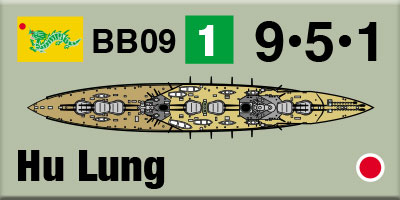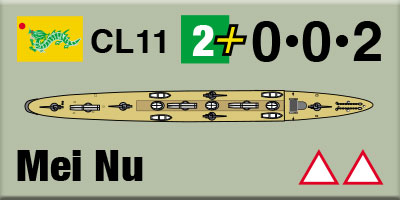Rise of the Dragon:
China Rising
by Mike Bennighof, Ph.D.
August 2024
 In crafting the alternative history of the Japanese Empire seen in Co-Prosperity Sphere, I wanted to build a believable set of circumstances that would allow Japan to fight the United States in the 1940’s on more or less even terms. In crafting the alternative history of the Japanese Empire seen in Co-Prosperity Sphere, I wanted to build a believable set of circumstances that would allow Japan to fight the United States in the 1940’s on more or less even terms.
Japanese leaders had seen their route to world power running through China, and to a large extent they were correct. Had Japan embarked on a course to dominate East Asia a generation earlier than was actually the case that effort would have included conflict with China, particularly were China herself attempting to modernize. Great War at Sea: Rise of the Dragon is based on that conflict that never happened.
Strong factions within the Imperial Chinese government indeed wished to modernize on the model of Japan’s Meiji Revolution. The Guangxu Emperor rose to the throne in 1875 when not yet four years old, with power remaining in the hands of his aunt, the Dowager Empress Cixi, who served as regent. Once the emperor reached the age of majority (16) in 1887, Cixi retained a great deal of power, frustrating his attempts to induce change in the Chinese system.
Believing that he had arranged military support to prevent a conservative coup, the Guangxu Emperor issued a sweeping set of changes in 1898, known as the Hundred Days Reforms. The new policies aimed at turning China into a constitutional monarchy on the model of Meiji Japan, including elected representative bodies at local, provincial and national levels. His aunt apparently bought off his supporters and fomented exactly the coup he had feared, that overturned the Hundred Days Reforms and reduced the Guangxu Emperor to a prisoner in his own palace while his top officials were executed.
 The humiliations of the 1902 Boxer Rebellion and subsequent foreign intervention changed the mind of the Dowager Empress. She began to support moves very similar to those that had caused her imperial nephew’s advisors to lose their heads, a program known as the New Policies. Those moves included an effort to expand and modernize the Imperial Navy, sparking Chinese exploration of dreadnought building in foreign yards. The humiliations of the 1902 Boxer Rebellion and subsequent foreign intervention changed the mind of the Dowager Empress. She began to support moves very similar to those that had caused her imperial nephew’s advisors to lose their heads, a program known as the New Policies. Those moves included an effort to expand and modernize the Imperial Navy, sparking Chinese exploration of dreadnought building in foreign yards.
The Guangxu Emperor died on 14 November 1908 and the Dowager Empress a day later, less than four month after issuing a constitution based on the Japanese model. A century later, forensic investigators determined that the emperor had likely been assassinated through arsenic poisoning.
The throne went to the Xuantong Emperor, better known as Pu-yi, the late ruler’s nephew. The conservative clique regained a great deal of power, opposing the new regent, Pu-yi’s father Prince Chun and managing to scuttle the naval building program along with the New Policies. Within three years bitter conservative opposition to any and all change had managed to sink an empire over 2,000 years old.
 Our alternative history departs from reality a little before this point. The Guangxu Emperor manages to avoid betrayal and arrest in 1898 and assert his authority over the Dowager Empress, pushing her into forced retirement as he had wished. A decade later, he manages to avoid being murdered by conservatives. The Hundred Days Reforms still meet fierce conservative opposition – abolishing the Confucian exam process for government positions, to cite just one example, called the authority of every Chinese bureaucrat into question. Our alternative history departs from reality a little before this point. The Guangxu Emperor manages to avoid betrayal and arrest in 1898 and assert his authority over the Dowager Empress, pushing her into forced retirement as he had wished. A decade later, he manages to avoid being murdered by conservatives. The Hundred Days Reforms still meet fierce conservative opposition – abolishing the Confucian exam process for government positions, to cite just one example, called the authority of every Chinese bureaucrat into question.
Thanks to the reform movement, the destructive energy of the so-called “Boxer” movement, the Righteous and Harmonious Fists, is channeled into sometimes-violent support for the emperor’s new policies. Enthusiastic young men enroll in the rapidly-expanding Imperial armed forces, seeing China strengthen herself to expel foreign oppressors. Most importantly for our alternative history, the eight-nation foreign invasion does not occur, and does not inflict the crippling Boxer Indemnity (forced payments totaling more than China’s annual tax revenue) on the Empire.
Daily Content includes no AI-generated content or third-party ads. We work hard to keep it that way, and that’s a lot of work. You can help us keep things that way with your gift through this link right here.
The Russo-Japanese War both inspired and frightened the Chinese people: an Asian nation had decisively defeated a European one, deploying modern technology and weapons. But that meant that another predator now stood right on China’s doorstep. Many Chinese admired Japanese achievements, but many more hated and feared the “Eastern Sea Devils.” The Chinese leadership understood that Russia’s defeat meant that the Japanese would only become even more eager to expand their influence. China had to prepare to defend herself.
 While the gap in economic productivity between China and Europe had widened enormously over the course of the previous century, the sheer size of the Empire still accounted for substantial productive capacity. China had made up 32.9 percent of the world economy in 1820, 17.2 percent in 1870 and 8.9 percent by 1913 (by comparison, China represented 11.47 percent of the world economy in 2012 and 18.34 percent in 2020). While the gap in economic productivity between China and Europe had widened enormously over the course of the previous century, the sheer size of the Empire still accounted for substantial productive capacity. China had made up 32.9 percent of the world economy in 1820, 17.2 percent in 1870 and 8.9 percent by 1913 (by comparison, China represented 11.47 percent of the world economy in 2012 and 18.34 percent in 2020).
That economy still draws eager foreign vultures; the reforms proceed amid opposition from not only domestic conservatives but also European, Japanese and American interlopers eager to derail them and keep China weak. Even so, the resources for a naval building program are available, and the Chinese can mitigate foreign interference to some extent by dangling the contracts for new warships, artillery and small arms in front of influential arms merchants and spreading the work around.
The political necessity of using arms purchases to stave off intervention and play the foreign devils against one another does keep China a dependent nation in defense terms – she is unable to build a full infrastructure of shipyards, steel mills and factories to supply her growing army and navy without substantial imports. Weapons, ships and ammunition still must be imported, though local production fills some needs including maintenance.
 To maintain the balance between the foreign predators, the Chinese felt themselves forced to place their dreadnought contracts almost simultaneously, buying two new ships each in Germany, Austria-Hungary and the United States and taking over three dreadnoughts under construction for Brazil in British yards. To maintain the balance between the foreign predators, the Chinese felt themselves forced to place their dreadnought contracts almost simultaneously, buying two new ships each in Germany, Austria-Hungary and the United States and taking over three dreadnoughts under construction for Brazil in British yards.
Where the Japanese had had decades over which to build their fleet, China did so in less than five years. That gave the new Imperial Navy a core of modern, powerful ships, but not the crews with which to man them. The battleships alone needed nearly 10,000 trained sailors. Naval academies had been opened in the 1870’s and 1880’s in Nanking, Foochow and Tientsin, but the training establishment had to be hurriedly enlarged with instructors imported from foreign navies, chiefly that of the United States. As a result, the Chinese have ships every bit as good as those of the Japanese if not superior, but they are not nearly as well-crewed.
The outbreak of the Great War allowed Japan a more or less free hand in the Far East, as the world’s eyes turned to the bitter struggles taking place in Europe. Confident in his newly-enlarged and modern army and navy, the Guangxu Emperor directs his diplomats to reject the impudent demands of the Eastern Sea Devils. If Japan wishes war, she will have it. The Chinese stall to allow mobilization, but the War of the Dragons begins in April 1915.
You can order Rise of the Dragon (second edition) right here.
Prince Chun’s Dreadnoughts
Russo-Japanese War (Playbook)
Rise of the Dragon (2e)
Retail Price: $99.98
Package Price: $80.00
Gold Club Price: $64.00
You can order Prince Chun right here.
Sign up for our newsletter right here. Your info will never be sold or transferred; we'll just use it to update you on new games and new offers.
Mike Bennighof is president of Avalanche Press and holds a doctorate in history from Emory University. A Fulbright Scholar and NASA Journalist in Space finalist, he has published a great many books, games and articles on historical subjects; people are saying that some of them are actually good.
He lives in Birmingham, Alabama with his wife, three children, and his new puppy. His Iron Dog, Leopold, could swim very well.
Daily Content includes no AI-generated content or third-party ads. We work hard to keep it that way, and that’s a lot of work. You can help us keep things that way with your gift through this link right here.
|
